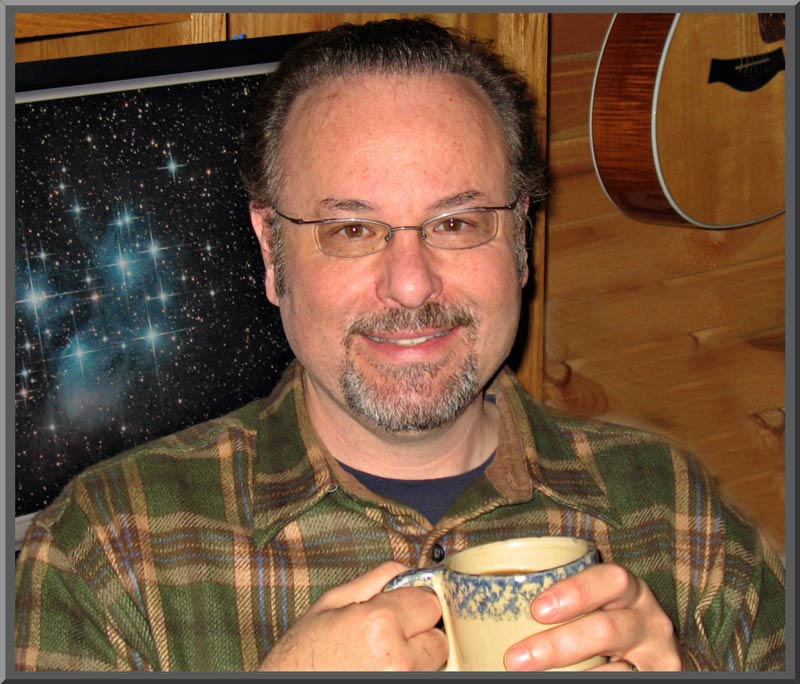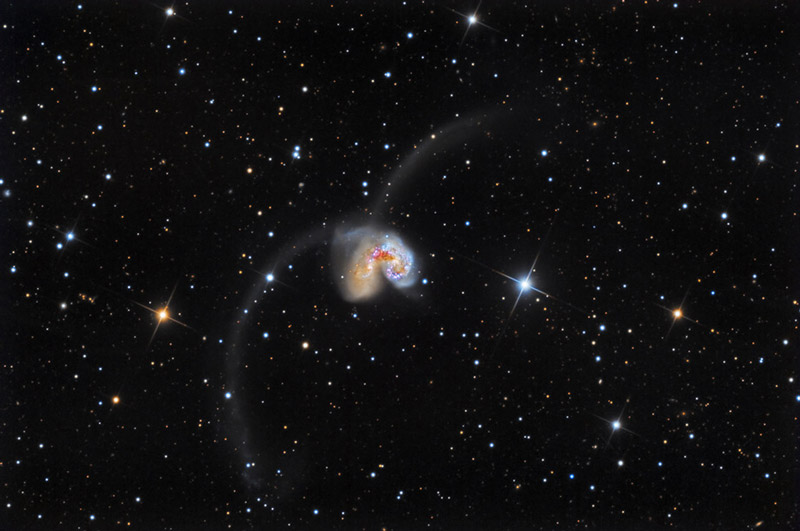Profile of Warren Keller
March 6, 2017Discuss this article in the forums The region near the star Alnitak in Orion's Belt showing the Flame Nebula (NGC 2024) and the Horsehead Nebula (IC 434 and Barnard 33). Data collected at Cherry Mountain Observatory and processed by Warren Keller.
The region near the star Alnitak in Orion's Belt showing the Flame Nebula (NGC 2024) and the Horsehead Nebula (IC 434 and Barnard 33). Data collected at Cherry Mountain Observatory and processed by Warren Keller.Overview
Astrophotographer Warren Keller has created some of the most artful CCD images of astronomical objects over the past 20 years. A musician and songwriter by training, Keller emphasizes the beauty of astrophotography and enjoys the thrill of the hunt for the endlessly beautiful shapes and colors throughout the universe.
Warren has lectured and led workshops at the North East Astro-Imaging Conference (NEAIC) in New York, the Midwest Astro-Imaging Conference (MWAIC) in Chicago, and the Advanced Imaging Conference (AIC) in San Jose. He has presented at the Winter, Texas, Okie-Tex and Black Forest Star Parties, and to groups as varied as Boy Scouts, Girl Scouts, Chambers of Commerce, Rotaries, and camera clubs. From 2009 to 2011, he was the North American rep for Atik Cameras and is a consultant to MSB-Astroart and Celestron where he co-designed their AstroFX software.
In this profile, Warren talks about his beginnings in astrophotography, his remote observing rig, his new book Inside PixInsight, and offers a few words of wisdom for new astro-imagers.
1. What inspired you to become an astrophotographer, and how long have you been involved in astrophotography?
I was inspired by a beautiful color image of the Dumbbell Nebula on the glossy dustcover of Fred Hoyle's 'Astronomy.' Also, just growing up in the exciting early days of the space program, the Apollo moon landings, Star Trek, Lost in Space, etc., was enough to direct me toward astronomy in general.
2. Other than doing astronomy and astrophotography, how do you spend most of your time?
Walking in nature with Jack the dog. Practicing saxophone and flute. Watching good TV with my wife Christine. She is a jewelry designer and we've gotten to travel in China, Hong Kong, and Macau for her business twice in 2016. While we were there, I had the opportunity to speak for Chinese National Astronomy twice, and also at the Hong Kong Space Museum.
 Warren Keller
Warren Keller3. How did you first learn astrophotography? Are you self taught or did you have a teacher?
I credit Jerry Lodriguss and Ron Wodaski as mentors via their websites and books. I also had a friend Barry Poteete in Nashville who was the telescope manager at Wolf Camera who was helpful. Although there were many fewer resources when I started than there are today, I read the web exhaustively. The books of Terence Dickinson and Michael Covington were also very valuable.
4. How or where do you collect most of your photons… with remote telescopes or with your own hands-on rig?
I did my own acquisition from 1998 to 2008 from locations in New Jersey, Pennsylvania, and West Virginia. Then I went with a remote telescope at New Mexico Skies for a few years. I am now a partner at SSRO (Star Shadows Remote Observatory) at CTIO (Cerro Tololo Inter-American Observatory) in the Atacama Desert of Chile, and that's where I acquire my image data now.
5. What's your current preferred equipment set-up (cameras, telescopes, and mounts)? Why did you choose this set of equipment?
The equipment at SSRO is actually owned by the University of North Carolina at Chapel Hill, so I don't have much say in the choices. We use a 16 inch F/11 RCOS and an FLI 16803 on a PlaneWave Ascension mount.
6. What's your favorite type of object to image?
Galaxies! I'm so excited to be able to image the lesser-known galaxies visible in the southern hemisphere.
 The interacting galaxies NGC 4038 and NGC 4039, also known as the ‘Antennae Galaxies', in the constellation Corvus. Data collected by Kenric Kattner near Fredericksburg, Texas, and processed by Warren Keller.
The interacting galaxies NGC 4038 and NGC 4039, also known as the ‘Antennae Galaxies', in the constellation Corvus. Data collected by Kenric Kattner near Fredericksburg, Texas, and processed by Warren Keller.7. How would you describe your style of astrophotography and processing? Are you interested more in the technical aspects or the artistic aspects of astrophotography?
I'd say I strive for a naturalistic approach, but with a touch of provocative edge with regard to color saturation and development of fine detail. With nebulae, I let myself be a touch more abstract- not unrealistic, but having a bit more 'pop'! I'm definitely more of an artist than a technologist.
8. Can you share one of your favorite imaging results?
Sure. A wonderful Horse Head and Flame Nebulae region acquired by David Plesko when he ran Cherry Mountain Remote Observatory. (See at the top of this page for this image)
9. You are known as an expert on PixInsight. For us beginners, what does this software do and how is it different than using standard non-astronomical imaging software like PhotoShop?
Well, I prefer to call myself an outstanding documentarian and communicator, but I actually don't consider myself an expert in either PixInsight or image processing in general. There's just so much to know, and I'm always learning and improving.
I think the unofficial PixInsight (PI) motto says it well: "For astro imagers by astro imagers." All of the tools are astro-specific. As powerful as Adobe Photoshop is, its tools have to be adapted to the needs of astro-image processors, and of course there is tons of stuff in Photoshop (PS) that we don't need. Although there are still a few clunky aspects of PI as compared with PS, it does an outstanding job of both pre-and post-processing. One of its most powerful aspects is excellent temporary visualization in the linear stage, which makes it easy to perform repairs and adjustments even before the initial nonlinear stretch. The tools for removing uneven field-illumination gradients, vignetting, etc., and the color calibration tool are outstanding. PI also takes a very different approach to image calibration, and to some degree, image integration (ie. stacking).
 Warren Keller's book Inside PixInsight
Warren Keller's book Inside PixInsight10. What motivated you to write a book about PixInsight?
The same thing that motivated me to produce my video tutorial series of 2012-2014 with Rogelio Bernal Andreo. I saw the need and the opportunity. Had I stuck with Photoshop and other astronomy software, I'd be dead in the water right now. Because I had the courage to plunge in despite my reservations and prior ignorance, I'm essentially the only game in town. While I hope someday that a technological and mathematical genius such as Juan Conejero, David Ault, etc. follows up with a more advanced tome, I'm pleased to be the first to put everything together in one place, and in an easy to follow way, providing the "What to do and when to do it" that's been so desperately needed by the community.
11. What do you wish you knew about astrophotography when you got started?
That it's difficult to do good work on the cheap. Better to buy an outstanding mount and skimp a bit on optics and camera, than the other way around. And certainly begin with a manageable focal length of 300 mm to 1,000 mm tops.
12. Do you have advice for beginning imagers?
Don't be seduced by sexy anodized things. Buying equipment you can't afford will not turn you into a Warren Keller or Adam Block or Rob Gendler. Again, great equipment can make the job easier, but at the end of the day, sky conditions are more important, and your image processing skills are the most important by far. There are a lot of brilliant guys in the hobby, but many of them have less of a handle on the artistic side of things. It takes time to develop an artist's eye and sensibility.
13. Where can we learn more about you and see more of your work?
My astrophotography site: www.billionsandbillions.com
My image processing tutorial site: www.ip4ap.com
The Advanced Imaging Conference site: www.aicccd.com
And you can find some of my musical work on SoundCloud: www.soundcloud.com/warrenkeller***
This article is © AstronomyConnect 2017. All rights reserved. Images © Warren Keller 2017.
Please login or register to watch, comment, or like this article.
Dismiss Notice
New Cookie Policy
On May 24, 2018, we published revised versions of our Terms and Rules and Cookie Policy. Your use of AstronomyConnect.com’s services is subject to these revised terms.

